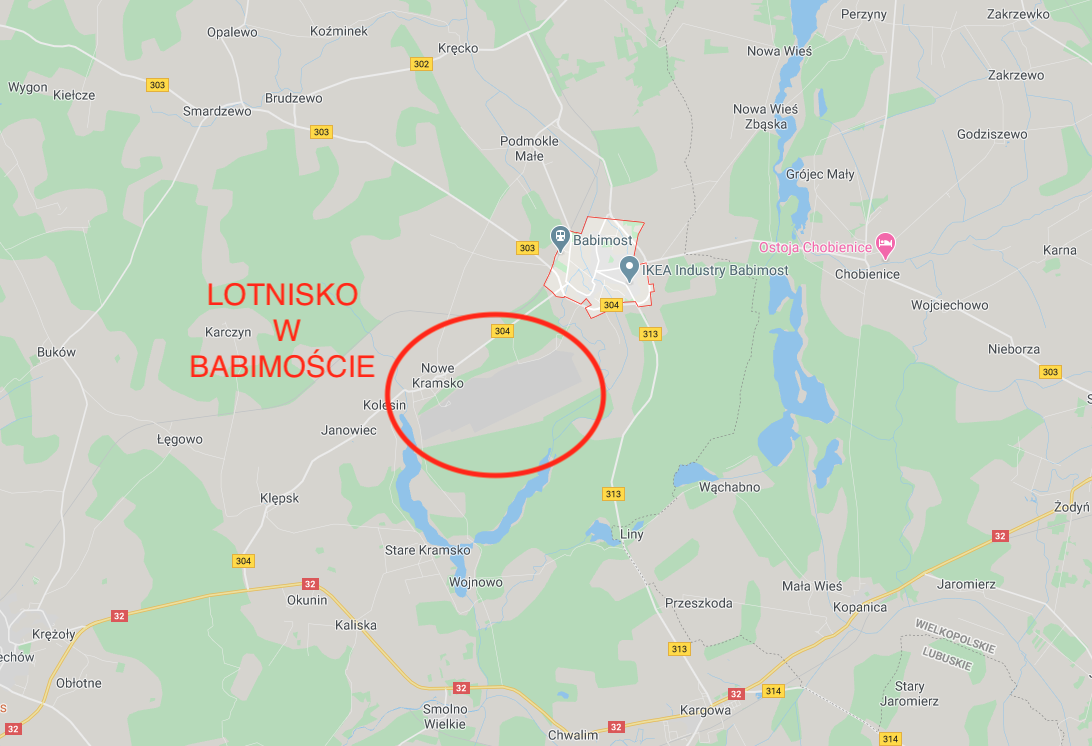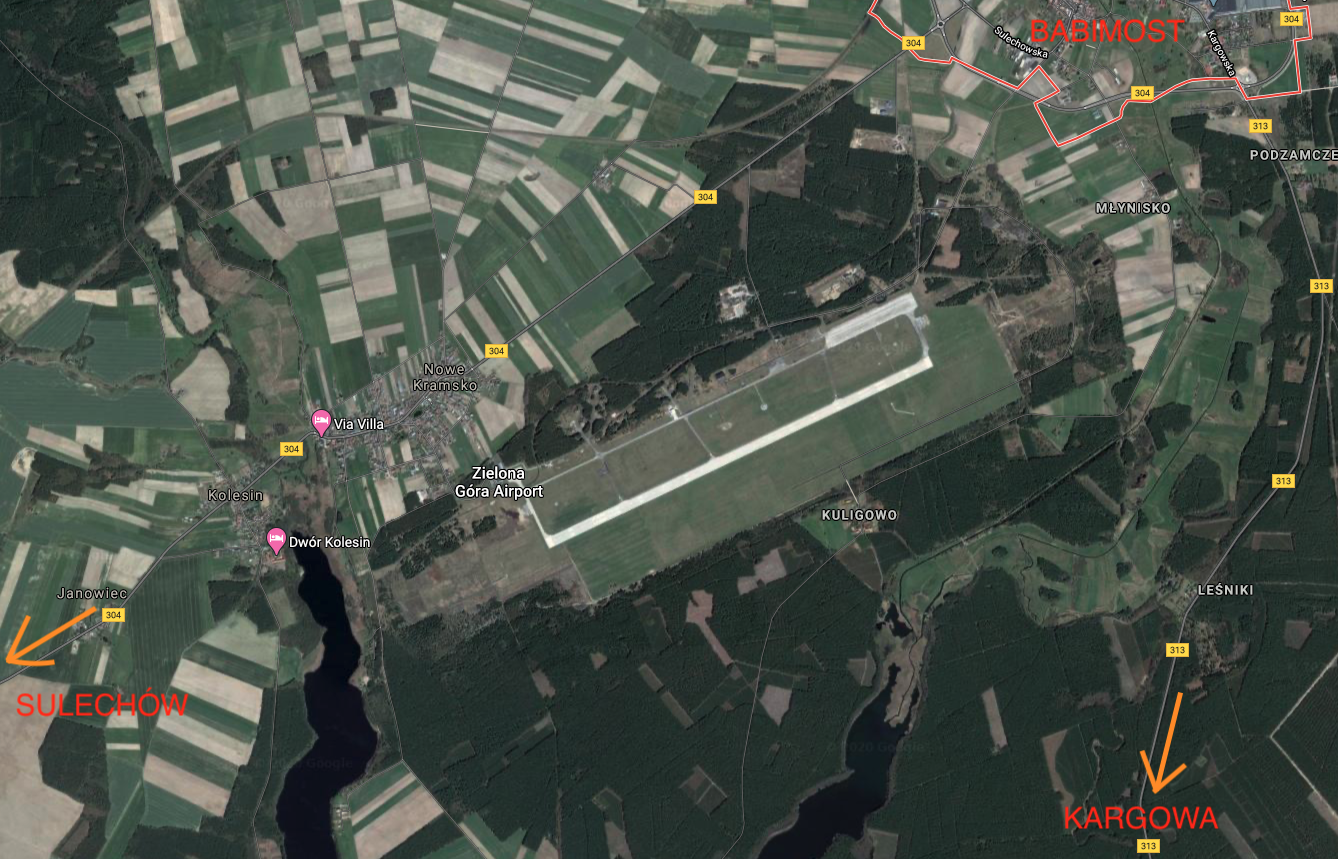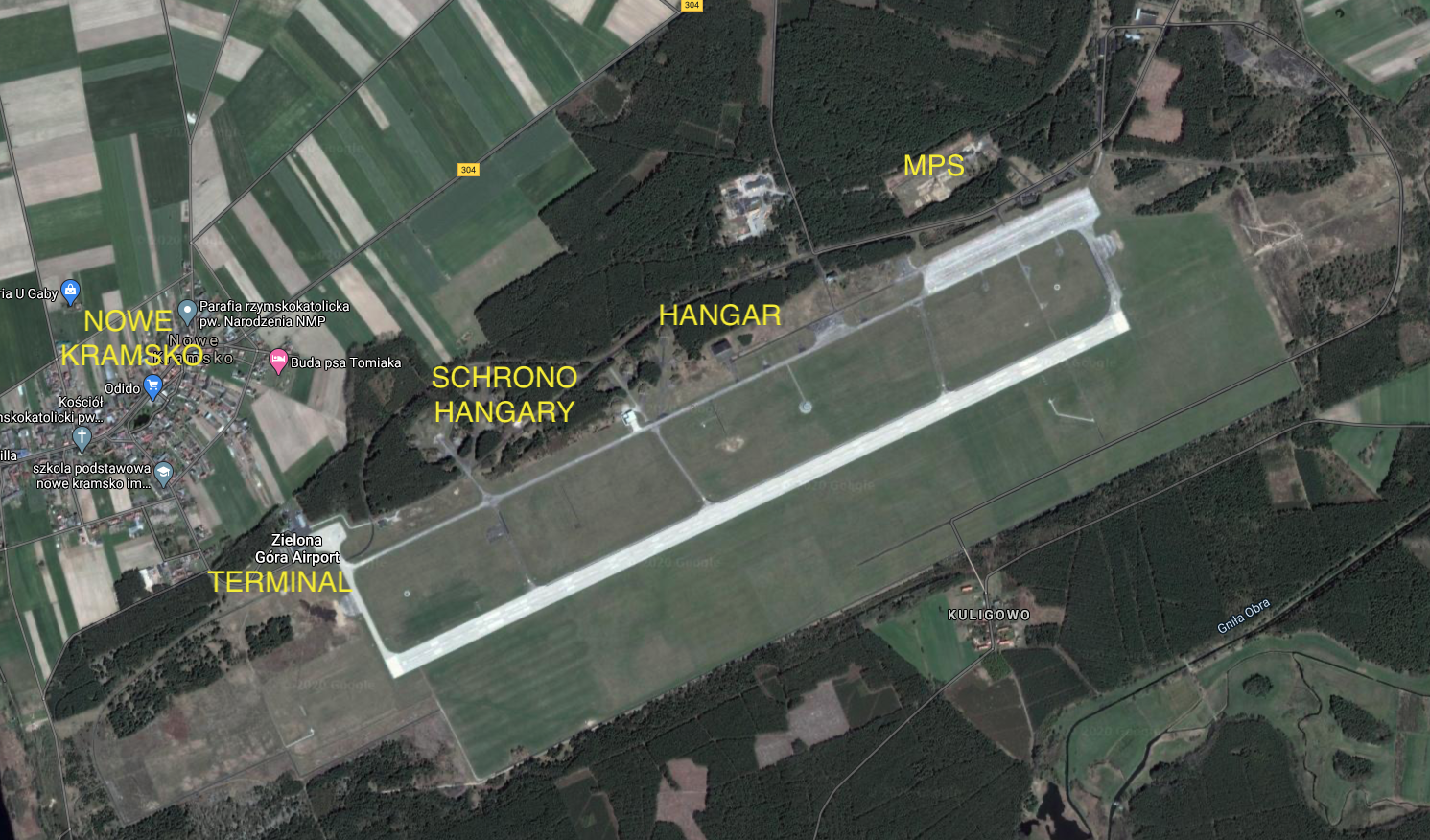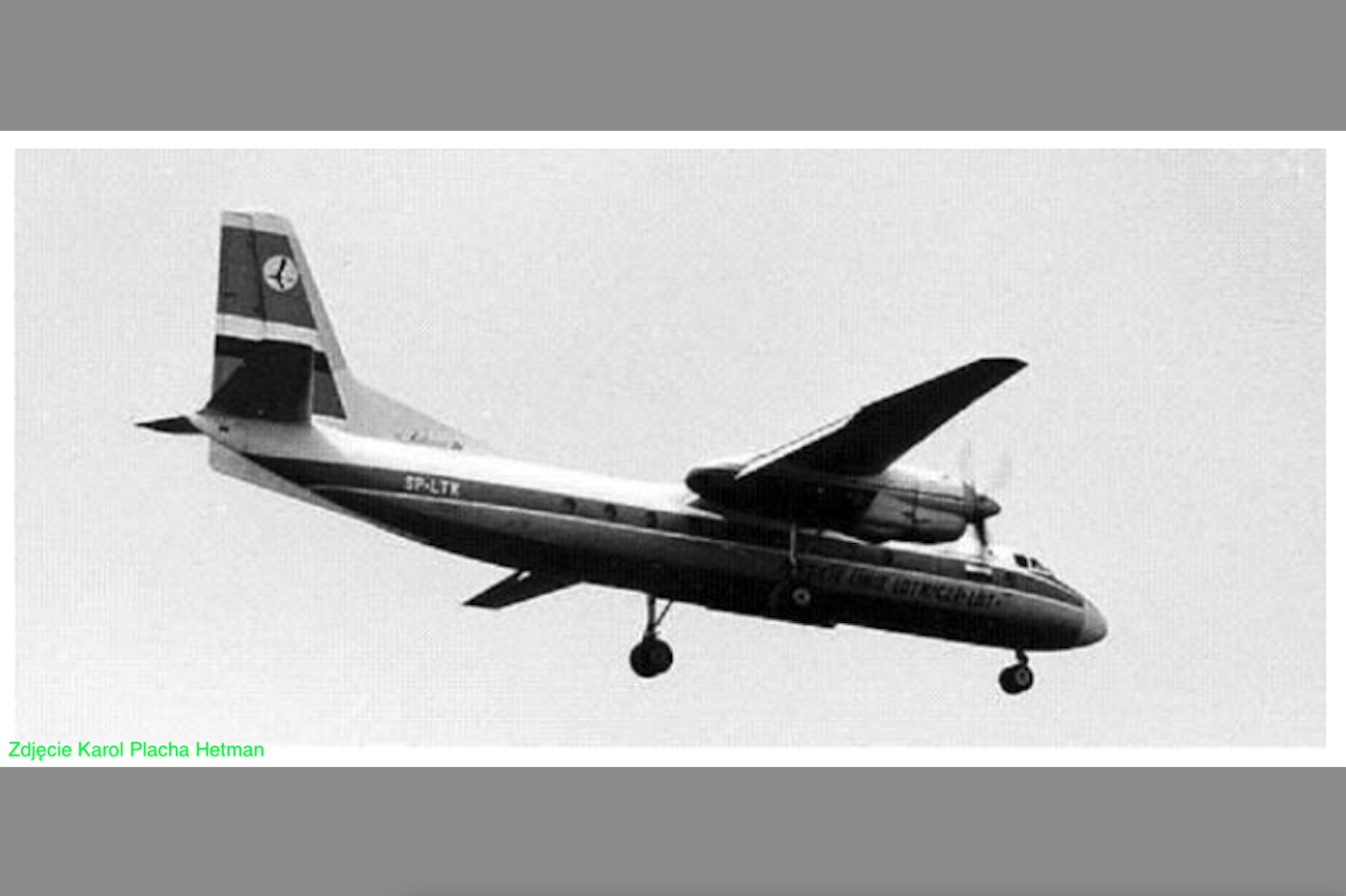Zielona Góra 2008-09-10
Lotnisko Babimost.
Współrzędne geograficzne: 52.138N 15.799E. Elewacja 59 m.
Loty cywilne z Babimostu. 1977 rok.
W 1977 roku, uruchomiono pierwsze połączenie pasażerskie na trasie Warszawa-Babimost, a trochę później połączenie Gdańsk-Babimost. Oczywiście w rozkładzie figurowało połączenie nie do Babimostu, ale do Zielonej Góry. Te 30 kilometrów dzielące lotnisko z centrum Zielonej Góry pasażerowie pokonywali autobusem. Przejazd autobusem był opłacony w cenie biletu lotniczego. W Zielonej Górze przystanek końcowy autobusu był koło Palmiarni. Podobne rozwiązania PLL LOT stosował w innych Polskich miastach, na przykład: Koszalin, a lotnisko w Zegrzu Pomorskim.
Na Lotnisku Babimost zbudowano także dworzec (terminal), a w nim uruchomiono kasę biletową, punkt odprawy pasażerów, poczekalnię i zaplecze. Uruchomiono także punkt odpraw zagranicznych. Pierwsze loty odbywano w okresie letnim dwa razy w tygodniu, a zimą jeden raz w tygodniu. Jednocześnie wiosną 1977 roku, w Zielonej Górze otwarto Biuro PLL LOT, gdzie kupowano bilety. Biuro to zostało zamknięte po 27 latach, w dniu 31 sierpnia 2004 roku.
Pierwszymi samolotami, które obsługiwały połączenia z Babimostu były sowieckie turbośmigłowe Antonow An-24. Sporadycznie w Babimoście lądowały także turbośmigłowe, ale czterosilnikowe Iliuszyn Ił-18.
W dniu 13 grudnia 1981 roku, generał Wojciech Jaruzelski wypowiedział Narodowi wojnę, ogłaszając wprowadzenie Stanu Wojennego i powodując WRON (wojskowa radę ocalenia narodowego, przez społeczeństwo nazwaną wroną). WRON wstrzymało między innymi wszystkie loty firmy PLL LOT. Przewozy ustały także w Babimoście. Dopiero po prawie dwóch latach samoloty PLL LOT wróciły do Babimostu.
Dzięki przemianom społeczno-gospodarczym w Polsce, od sierpnia 1991 roku, we flocie PLL LOT pojawiły się nowe regionalne francusko-włoskie samoloty ATR-42 i ATR-72, które zastąpiły wysłużone An-24. Nowe maszyny zaczęły pojawiać się w Babimoście. Wzrosła także liczba samolotów wykonujących loty czarterowe. W 1997 roku, do życia została powołana firma córka nazwana EuroLOT, która systematycznie przejmowała sieć krajowych połączeń i samoloty ATR-42 i ATR-72.
Koniec 90-lat, to był bardzo słaby okres przewozów pasażerskich w Babimoście. W 1999 roku, było 198 pasażerów i 100 operacji lotniczych, a w 2000 roku, 207 pasażerów i zaledwie 36 operacji lotniczych. Dlatego na przełomie 2000/2001 roku, EuroLOT przystąpił do modyfikowania połączeń pod kątem ekonomiczności. Od dnia 25 marca 2001 roku, uruchomiono stałe połączenie pasażerskie z Okęciem z międzylądowaniem na lotnisku Poznań-Ławica. Czyli Babimost miał połączenie z Poznaniem i Warszawą. Trasa ta istniała do 1 września 2004 roku, kiedy zarząd EuroLOT z powodów ekonomicznych zlikwidował to połączenie i Babimost stracił połączenie ze światem. Tylko dzięki wytrwałości władz regionu, po 15 miesiącach przerwy wznowiono loty w dniu 28 listopada 2005 roku, dwa razy dziennie.
Po ograniczeniach wprowadzonych przez PLL LOT w dniu 25 marca 2007 roku, firma PLL LOT podpisała kontrakt z firmą Jet Air na obsługę linii Babimost-Okęcie. Firma ta obsługiwała trasę samolotami turbośmigłowymi BAe Jetstream 32 pięć razy w tygodniu. Podróż trwała około 75 minut. Obecnie (2009 rok) firma Jet Air obsługuje to połączenie jako własne, niezależne od PLL LOT. Uruchomiła także połączenie do Bydgoszczy.
BAe Jetstream 32 to samolot angielskiej produkcji o długości 15 m i rozpiętości skrzydeł 16 m. Bez tankowania może latać około 5 godzin. Może osiągnąć pułap nawet 8 000 m, rozwijając przy tym maksymalną prędkość ponad 400 km/godz. Samolot ma dwa silniki turbośmigłowe i najwyższą w swojej klasie kabinę o wysokości 1,8 m. Dla pasażerów jest 19 skórzanych foteli oraz napoje i przekąski serwowane przez asystentkę pokładową.
Rozkład lotów (2006 rok):
Start z Babimostu godz. 6.25 – lądowanie w Warszawie godz. 7.45 ( pn.-sob ) ( od 3 stycznia godz. 5.50 – 7.10 ) Start z Warszawy godz. 12.20 – lądowanie w Babimoście godz. 13.40 ( pn.-sob., niedz. ). Start z Babimostu godz. 14.05 – lądowanie w Warszawie godz. 15.25 ( pn.-sob., niedz. )Start z Warszawy godz. 19.35 – lądowanie w Babimoście godz. 20.55 ( pn.-sob., niedz. ). Lot w jedną stronę kosztował od 172 złotych do 540 złotych ( bilet w ostatniej chwili ).
W 2008 roku, zmodyfikowano połączenie z Okęciem poprzez międzylądowanie w Bydgoszczy. Przewozy w Babimoście były niewielkie i stanowiły poniżej 0,05 % wszystkich przewozów w Rzeczypospolitej Polskiej.
W okresie letnim 2009 roku, firma Jet Air uruchomiła połączenie Warszawa – Babimost – Drezno. Oznacza to dla lotniska pierwsze zagraniczne stałe połączenie. Dzięki temu lotnisko podniosło swoją renomę i zwiększyło szanse na uzyskanie funduszy unijnych. W tej chwili (2009 rok) kursy z Babimostu obsługują samolot 18-miejscowy. Jeśli pasażerów będzie przybywać, ma być podstawiona maszyna z 46 miejscami na pokładzie.
W styczniu 2011 roku, zawieszono loty do Warszawy. Lotnisko obsługiwało jedynie samoloty prywatne i czasami wojskowe samoloty transportowe. Od czerwca 2011 roku, zostały wznowione bezpośrednie loty do Warszawy. Szlak ten do 2016 roku, obsługiwały linie Sprint Air, a od marca 2017 roku, PLL LOT. W 2019 roku, wznowiono loty czarterowe. wykonywano między innymi loty do Turcji, lotnisko Antalya.
Przejęcie Lotniska Babimost przez władze cywilne.
Już w 90-latach władze wojewódzkie podjęły starania o uzyskanie prawa własności do lotniska. Wojsko początkowo nie chciało pozbywać się tego obiektu i proponowano wspólne zarządzanie. Kryzys przewozowy końca 90-lat nie sprzyjał staraniom o przejęcie lotniska.
Ponownie, okres 2001-2004, wywołał temat przejęcia lotniska przez administrację cywilną. Tym bardziej, że w 2004 roku, Wojska Lotnicze całkowicie przekazały teren i obiekty do AMW. To wówczas stało się jasne, że Wojsko chce lotnisko sprzedać. Od 2005 roku, Lotnisko Babimost pełni wyłącznie funkcje cywilne; loty pasażerskie regularne i czarterowe, loty medyczno-ratownicze, loty prywatne-biznesowe.
W 2005 roku, Województwo Lubuskie miało kupić część lotniskową portu lotniczego. A konkretnie; RWY, DK i części hangarów. Niestety, wbrew zapowiedziom umowy nie dało się podpisać. AMW poinformowała, że przyczyną wstrzymania transakcji była prowadzona analiza zagospodarowania lotnisk powojskowych przez Komisję Infrastruktury Sejmu. Już wówczas planowano zawiązanie Spółki Samorządowej z udziałem PPL. Za grunt ustalono, że opłata wyniesie jedynie 5 % wartości, czyli 2 200 000 złotych. Zabezpieczano także środki finansowe na 2006 rok; zielonogórski magistrat – 450 000 złotych, Marszałek Województwa – 1 150 000 złotych.
Jak można skutecznie utrudnić rozwój Lotniska Babimost i wielu innych lotnisk w Rzeczypospolitej Polski, przekonaliśmy się w 2007 roku. Rządząca wówczas Partia Prawo i Sprawiedliwość opracowała projekt ustawy o komunalizacji lotnisk powojskowych i wojskowych niepotrzebnych już wojsku. Komunalizacja oznaczała przejęcie lotnisk przez samorządy i przekazanie ich spółkom, bez pozbywania się kontroli nad nimi. Ustawa była oczkiem w głowie większości lubuskich polityków. To od niej miało się rozpocząć budowanie potęgi Babimostu, jako lotniska cywilnego i cargo. Niestety oddanie majątku samorządom nie bardzo podobało się drugiej partii Platformie Obywatelskiej (masoneria), dlatego partia ta wniosła własny projekt. Przecież można wzbogacić się prywatnie na majątku narodowym. Co ciekawe, projekt ustawy PiS, przewidywał wykaz lotnisk w osobnym zarządzeniu ministerialnym. PO bardzo to rozwiązanie krytykowała, po czym w 2008 roku, rządząc już w Rzeczypospolitej Polskiej przyjęła ustawę właśnie z takim rozwiązaniem. Co za obłuda. Trzeba także pamiętać, że w tym okresie lotniska w Poznaniu (Ławica) i Wrocławiu (Starachowice) nie można już było dalej rozbudowywać, bo w pobliżu znajdują się osiedla mieszkaniowe. Natomiast Lotnisko Babimost ma wielkie możliwości.
W czerwcu 2007 roku, Samorząd Zielonej Góry i Województwa Lubuskiego oraz Przedsiębiorstwo Państwowe Porty Lotnicze (zarządca lotniska) podpisały wstępną umowę na uruchomienie działu cargo.
W 2008 roku, Marszałek Województwa Lubuskiego zamierzał powołać Spółkę. Jej udziały kierowano do Samorządów Miast; Babimost, Nowa Sól, Zielona Góra oraz do inwestorów prywatnych. Planowo, że do 2012 roku, Samorządy Województwa, Polska Agencja Żeglugi Powietrznej i Porty Lotnicze zamierzają zainwestować w Lotnisko Babimost blisko 41 mln zł. Powstał już harmonogram inwestycji – od największych, jak rozbudowa terminalu, po zakupy schodów i maszyn do malowania pasów startowych.
Na lotnisku ma powstać nowy zbiornik na paliwo na 30 000 litrów (obecnie są dwa zbiorniki na 7 500 i 18 000 litrów). Do Babimostu przylatywało tankować wiele awionetek z rajchu. Skoro im się opłacało lecieć 100 km, to czas było pomyśleć o większej stacji paliw. Do końca grudnia 2008 roku; wyremontowano budynek odpraw towarowych Cargo, garaż na sprzęt handlingowy (podstawy pod koła, ogrzewacze, końcówki do tankowania).
W 2009 roku, na lotnisku uruchomiono system nawigacji radiolokacyjnej DVOR DME, kosztujący około 3,5 milionów złotych. System ILS, warty około 5 milionów złotych zostanie zamontowany w 2011 roku. Zamontowano oświetlenie ścieżki schodzenia, RWY i DK. Cały teren ogrodzono nowym płotem (koszt 4 milionów złotych). Poczyniono już prace w kierunku rozbudowy parkingów.
Dopiero 2009 roku, samorząd przejął Lotnisko Babimost. W dniu 9 lutego 2009 roku, Sejmik Województwa Lubuskiego upoważnił Zarząd Województwa do przejęcia Lotniska Babimost w formie darowizny. Tym samym skończyła się wieloletnia dyskusja, przejmować lotnisko czy też pozostawić je w rękach Agencji Mienia Wojskowego. zarządzaniem portem. Wejść do niej mają przedstawiciele marszałka, prezydenta Zielonej Góry, gminy Babimost, przedsiębiorstwa Porty Lotnicze, ewentualnie inne firmy. Rozwój Lotniska Babimost zależy od ogólnego rozwoju lotnictwa w Polsce. Będzie dobrze jeżeli lotnisko będzie bazą choć jednego przewoźnika (niskokosztowego). Poza tym nierealny jest rozwój w oparciu wyłącznie o przewozy pasażerskie. Musi się uruchomić ruch towarowy, a to jest bardzo realne. Babimost ma jedną przewagę – twarda płyta przyjmie niemal każdego Boeinga. Poznańskie Krzesiny jeszcze nie.
Lotnisko Babimost jest jedynym Portem Lotniczym Pasażersko-Towarowym w Województwie Lubuskim. Ewentualny obszar oddziaływania lotniska na ruch pasażerski liczy zaledwie około 3 milionów Polaków zamieszkujących zachodnią Wielkopolskę i Ziemie Lubuską. Ta mała liczba potencjalnych pasażerów ogranicza dynamikę przewozów. W 2008 roku, Port był dopiero na 11 miejscu wśród Polskich Portów.
Odległości lotniska w Babimoście do większych miast regionu: Zielona Góra – 30 km, Gorzów – 80 km, Wolsztyn – 25 km, Sulechów – 14 km, Świebodzin – 26 km, Zbąszyń – 24 km, Nowa Sól – 40 km, Żagań – 71 km, Żary – 77 km, Kostrzyn – 95 km, Głogów – 90 km. Lotnisko leży przy tak zwanej aglomeracji zwanej Lubuskim Trójmiastem, czyli Miasta; Sulechów, Zielona Góra i Nowa Sól. Zamieszkuje je łącznie około 290 tysięcy mieszkańców. Jest on dobrze połączony drogowo z Miastem Zielona Góra ( 118 tysięcy mieszkańców ), leżącym 34 km na południowy-zachód. Czas dojazdu wynosi 30 minut, a jeszcze ulegnie skróceniu po oddaniu do użytku obwodnicy Sulechowa. Większość drogi dojazdowej to drogi szybkiego ruchu. Odległość drogami do Poznania to 95 km, z czego 65 km to autostrada, czyli dojazd nie przekracza 60 minut. Lecz w Poznaniu jest dobrze funkcjonujący Port Lotniczy Ławica. Do Portu można także dojechać koleją do Stacji Zbąszynek i dalej busami ( mikrobusami ). W przyszłości istnieje możliwość uruchomienia kolejowego do samego portu korzystając z istniejącej bocznicy kolejowej. Orientacyjny koszt TAXI z lotniska do centrum Zielonej Góry ( 80 km ) to 130 zł.
Dane Lotniska w Babimoście (Zielona Góra). 2020 rok.
Adres: PORT LOTNICZY ZIELONA GÓRA – BABIMOST, skrytka pocztowa 4, 66-110 Babimost.
Współrzędne geograficzne; 52 stopnie 08 minut szerokości N i 15 stopni 47 minut długości E. Inaczej; 52.138N 15.799E. Elewacja 59 m (194 ft). Kod IATA – IEG, Kod ICAO – EPZG. Łączność – Częstotliwość: TWR 118,750 Mh. Dane: ILS LOC IZGA 111.300 MHz, ILS GP/DME 332.300 IZGA CH 50X, DVOR/DME ZLG : 110,650 MHz.
Od 2005 roku, Lotnisko Babimost pełni wyłącznie funkcje cywilne. Jest przeznaczone dla ruchu pasażerskiego, towarowego, sanitarnego i prywatno-biznesowego. Jest to port lotniczy o regularnym, narodowym ruchu lotniczym z dużymi perspektywami. Wolno i z trudem rozwijający się, ale systematycznie.
Lotnisko leży przy drodze wojewódzkiej Nr 304 z Babimostu do Sulechowa. Bezpośrednio od tej drogi biegnie szosa do Portu Lotniczego, która także ma statut drogi wojewódzkiej i ma Nr 456. Do samego lotniska można także dojechać drogą gminną biegnąca z centrum Babimostu o długości około 3 km.
Lotnisko zajmuje powierzchnię 450 ha. Na jego zabudowę składają się; terminal pasażerski (dworzec lotniczy), terminal cargo, budynki technicznego zabezpieczenia, instalacje i wyposażenie techniczne obsługi pasażerów, ładunków i samolotów oraz 16 byłych schronohangarów samolotowych (każdy o powierzchni 320 m kwadratowych), które stały się magazynami cargo. Na lotnisku jest także hangar wykorzystywany przez lotnictwo cywilne.
Lotnisko wyposażone jest w DS (RWY) 2 500 m x 60 m, na kierunku 06/24. Nawierzchnia betonowa. Światła podejścia i drogi startowej: ALPA-ATA cat.I SFL. Kierunek 24-system podejścia precyzyjnego kategorii I-ej, „krzyż” o długości 900m LIH, oś błyskowa. Kierunek 06-uproszczony świetlny system podejścia precyzyjnego – „krzyż” z osią na długości 420m i poprzeczką w odległości 300m od THR wizualny system podejścia. Światła PAPI: kierunek 24-PAPI, kąt ścieżki schodzenia 3st. w odległości 306m od THR 24 po lewej stronie RWY. kierunek 06-PAPI kąt ścieżki schodzenia 3st. w odległości 320m od THR 06. RWY – DS zmodernizowana w 1989 roku: nowa nawierzchnia betonowa o grubości 45÷47 cm wraz z oświetleniem krawędziowym i progów. W roku 2008 wykonano wymianę dylatacji, naprawiono pęknięcia i ubytki nawierzchni, odnowiono malowanie poziome. Nośność nawierzchni: PCN 57/R/A/W/T.
Lotnisko ma 3 płyty postojowe samolotów o łącznej powierzchni 57 000 m 2. Główna płyta PPS-1 może być wykorzystywana do postoju samolotów o literze kodu F. Aktualnie samoloty mogą korzystać tylko z RWY, jednej drogi kołowania i płyty peronowej przy terminalu. Kołowanie samolotów jest realizowane przez RWY.
Terminal pasażerski ma przepustowość 150 000 pasażerów rocznie. Lotnisko posiada bezpłatny, strzeżony parking, czynny całą dobę. Na lotnisku nie ma placówek usługowych, bankomatów, przechowalni bagażu.
Na lotnisku działa stałe lotnicze przejście graniczne. W porcie funkcjonuje Lotniskowy Komisariat Policji. Port jest strzeżony przez całą dobę. Nie jest objęty normami hałasu, co powoduje, że port może być użytkowany całodobowo. Dzięki temu nie ma też ograniczeń na hałas emitowany przez posowieckie maszyny, które już nie spełniają norm hałasu. Niemniej jednak lotnisko przyjmuje samoloty w czasie między godziną 06;00, a godziną 22;00.
Lotnisko może obsłużyć każdy obecnie eksploatowany samolot pasażerski i transportowy; Boeing 737/747/757/767/777/787, Airbus A300/310/320, Tu-134/154, ATR 42/72, An-40/42, Embraer 170/190, Ił-62/76, C-17, CASA C-295.
Lotnisko posiada Lotnicze Służby Ratunkowe, które mają na stanie dwa wozy bojowe. Lotniskowy komisariat Policji został zlikwidowany w chwili utworzenia Służby Ochrony Lotniska. Lotnisko ma urządzenie meteorologiczne AWOS7.
Trzeba także dodać, że zgodnie z prawem część obszaru byłego lotniska woskowego porośnięty lasami został przekazany pod zarząd Lasów Państwowych i nie podlega innemu zagospodarowaniu.
Skład paliw.
Na lotnisku ma stanąć nowy zbiornik na paliwo o pojemności 30 m sześciennych (obecnie są to dwa zbiorniki na 7,5 m sześciennego i 18 m sześciennych ). Na lotnisku znajduje się dawny skład paliw, eksploatowany przez wojsko do 2004 roku, który został przez AMW wystawiony na sprzedaż. Jego obszar to 9,533 hektarów, na działce nr 1299/41. Nieruchomość posiada urządzona księgę wieczystą KW nr 24548. Działka jest ogrodzona, oświetlona, z doprowadzona siecią wodociągową i hydrantową p.poż, wewnętrznymi drogami dojazdowymi. Na terenie jest 20 budynków różnego przeznaczenia ( warsztat, magazyn, przepompownia MPS, punkty przyjmowania i wydawania paliw, i.in. ) o łącznej powierzchni użytkowej 777 m kwadratowych, 3 budowle (wiata, stojak na węże paliwowe, rampa wjazdowa MPS ) o łącznej powierzchni użytkowej 95 m kwadratowych. Pojemność wszystkich zbiorników paliwowych to 2 150 m sześciennych. Znajdują się tu także 3 zbiorniki p/poż o łącznej pojemności 110 m sześciennych. Rodzaje paliwa: Avgas 100 LL, Jet – A1. Urządzenia do tankowania: Autocysterny: Avgas 100 LL – 7 500 litrów, Jet A 1 – 18 000 litrów.
Ruch lotniczy.
1999 rok, 198 pasażerów, 100 operacji lotniczych. 2000 rok, 207 pasażerów, 36 operacji lotniczych. 2001 rok, 5624 pasażerów, 615 operacji lotniczych. 2002 rok, 7598 pasażerów, 681 operacji lotniczych. 2003 rok, 7813 pasażerów, 1237 operacji lotniczych. 2004 rok, 3949 pasażerów, 400 operacji lotniczych. 2005 rok, 427 pasażerów, 163 operacji lotniczych. 2006 rok, 8 316 pasażerów, 1107 operacji lotniczych. 2007 rok, 6 739 pasażerów, 714 operacji lotniczych. 2017 rok, 10 321 pasażerów, 987 operacji lotniczych. 2018 rok, 15 543 pasażerów, 1 254 operacji lotniczych. 2019 rok, 33 783 pasażerów, 1 778 operacji lotniczych.
Opracował Karol Placha Hetman





